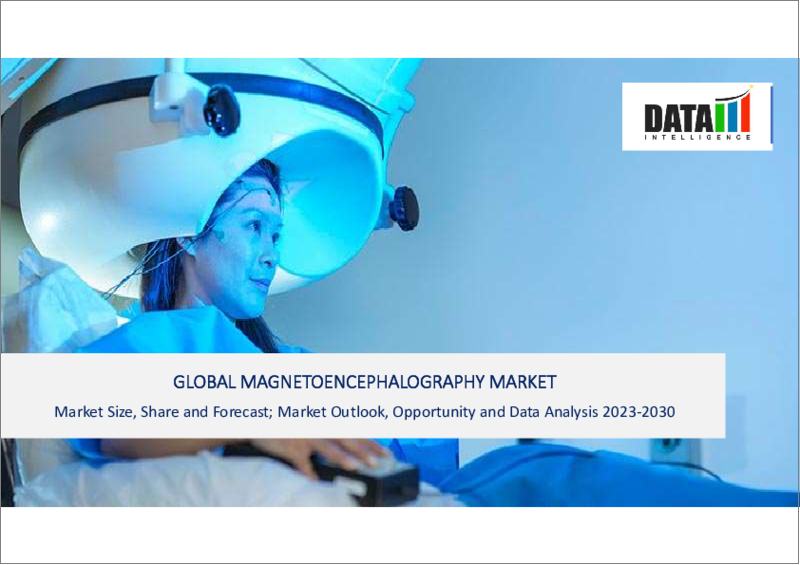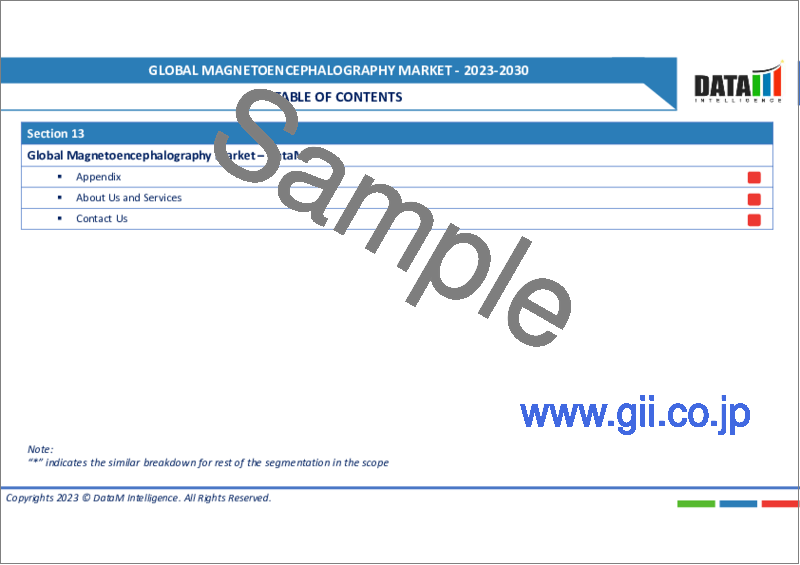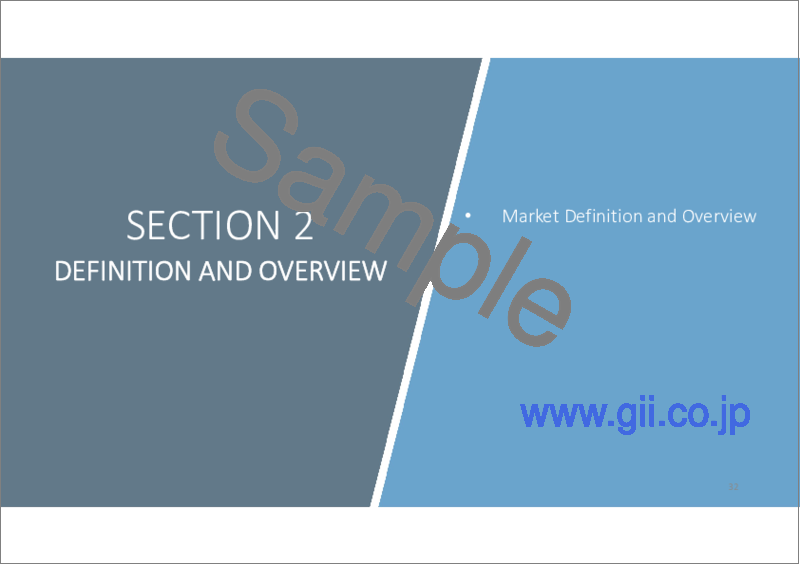|
|
市場調査レポート
商品コード
1319142
脳磁図の世界市場-2023年~2030年Global Magnetoencephalography Market - 2023-2030 |
||||||
カスタマイズ可能
適宜更新あり
|
|||||||
| 脳磁図の世界市場-2023年~2030年 |
|
出版日: 2023年07月31日
発行: DataM Intelligence
ページ情報: 英文 195 Pages
納期: 即日から翌営業日
|
- 全表示
- 概要
- 目次
市場概要
脳磁図の世界市場は、2022年に2億7,380万米ドルに達し、2030年には4億880万米ドルまで成長すると予測されています。世界の脳磁図市場は、予測期間中(2023-2030年)にCAGR 5.2%を示すと予測されています。
てんかん患者の検査や手術計画は、脳磁図検査から大きな恩恵を受けます。てんかん原性領域とは、てんかん発作を引き起こす脳の異常活動の正確な領域を指します。この情報は、重要な機能領域を保護しながら、損傷した脳組織を切断または除去するための最適な外科的アプローチを選択するために不可欠です。
市場力学
脳研究への注目の高まりが、予測期間中の世界の脳磁図市場の成長を後押ししています
脳の健康は常に変化している概念であり、健康産業だけでなく一般大衆からも注目されているが、これにはそれなりの理由があります。人生の後半に臨床的な認知症につながる神経変性変化を阻止する最大の戦略は、危険因子の早期発見と管理であるにもかかわらず、脳の健康への危険に関する調査は依然として中高年者を対象としています。
脳の健康を管理するための地域ベースのサービスによって、コミュニケーションと早期リスクプロファイリングの新たな機会が提供されます。その結果、認知症の疫学や治療法の有効性に関する我々の知識を前進させる、大量のデータが生み出されると思われます。
臨床診断におけるアプリケーションの増加は、世界の脳磁図市場の成長機会を提供します
MEGは、一部の患者における脳震盪の臨床診断技術としての可能性を示しています。ミリ秒の時間分解能を持つMEGは、脳の機能解剖学的構造をマッピングする非侵襲的な方法です。これは、神経細胞の電気的活動によって生じる磁場を検出することによって行われます。軸索の束から発生するシナプス後電位は、MEGが拾い上げることのできる磁場を伴う細胞内電流をもたらします。
MEGでは、頭蓋骨の表面全体に設置された高精度で高度なセンサーを使って磁場をとらえます。X線、外部磁場、放射性同位元素(核医学で使用)を必要とせず、画像を作成することができます。正常な脳活動と病的な脳活動を場所と時間で区別する能力において、MEGは既存の技術を進歩させています。磁場を検出することにより、各磁場を作り出す細胞集合体をミリ秒単位の時間分解能で特定することができます。
COVID-19の影響分析
COVID-19パンデミックは、脳磁図市場に大きな影響を与えました。パンデミックは、サプライチェーンの混乱、物流の困難、財務上の不確実性を引き起こしました。これらの要素は、MEGシステムの設置や取得の遅れにつながった可能性があります。予算が厳しいホスピタリティ、研究施設、クリニック、あるいは流行がもたらした差し迫った医療ニーズに対応する病院は、新しいMEG装置の購入を遅らせたり、規模を縮小したりした可能性があります。
ロシア・ウクライナ紛争分析
ロシアとウクライナの戦争が脳磁図市場に与える影響は複雑で多面的です。紛争による混乱のため、病気のサーベイランスやスクリーニングのイニシアチブを成功裏に実施することは難しいです。疾病サーベイランスと対応が妨げられ、伝染病の特定と封じ込めが遅れる可能性があります。
目次
第1章 調査手法と調査範囲
第2章 定義と概要
第3章 エグゼクティブサマリー
第4章 市場力学
- 影響要因
- 促進要因
- 認知症の増加
- 抑制要因
- 脳磁図に関する課題
- 機会
- 臨床診断におけるアプリケーションの増加
- 影響分析
- 促進要因
第5章 産業分析
- ポーターの5フォース分析
- サプライチェーン分析
- アンメットニーズ
- 規制分析
第6章 COVID-19分析
第7章 ロシア・ウクライナ戦争分析
第8章 人工知能分析
第9章 用途別
- 臨床
- 認知症
- 自閉症
- 統合失調症
- 多発性硬化症
- 脳卒中
- てんかん
- その他
- 調査
第10章 エンドユーザー別
- 病院
- 画像診断センター
- 学術研究機関
第11章 地域別
- 北米
- 米国
- カナダ
- メキシコ
- 欧州
- ドイツ
- 英国
- フランス
- イタリア
- スペイン
- その他欧州
- 南米
- ブラジル
- アルゼンチン
- その他南米
- アジア太平洋
- 中国
- インド
- 日本
- オーストラリア
- その他アジア太平洋地域
- 中東・アフリカ
第12章 競合情勢
- 競合シナリオ
- 製品ベンチマーク
- 企業シェア分析
- 主な発展と戦略
第13章 企業プロファイル
- Compumedics Limited
- 会社概要
- 製品ポートフォリオと説明
- 財務概要
- 主な発展
- MEGIN
- Ricoh USA, Inc.
- CTF MEG INTERNATIONAL SERVICES LP
- FieldLine Inc.
- Cerca Magnetics Limited
- Croton healthcare
第14章 付録
Market Overview
The global Magnetoencephalography Market reached US$ 273.8 million in 2022 and is projected to witness lucrative growth by reaching up to US$ 408.8 million by 2030. The global Magnetoencephalography market is expected to exhibit a CAGR of 5.2% during the forecast period (2023-2030).
The examination and surgical planning of individuals with epilepsy benefit greatly from Magnetoencephalography. The epileptogenic zone the precise area of aberrant brain activity that causes seizures can be located with the aid of this technique. This information is essential for selecting the best surgical approach to disconnect or remove damaged brain tissue while protecting critical functional regions.
Market Dynamics
Increased focus on brain research is boosting the global magnetoencephalography market growth during the forecast period.
Brain health is a concept that is always changing, gaining attention from the health industry as well as from the general public, and it does so for good reasons. Despite the greatest strategy to stop neurodegenerative changes that lead to clinical dementia later in life is early detection and control of risk factors, research on hazards to brain health still focuses on middle-aged and older persons.
New chances for communicating and early risk profiling are offered by community-based services for managing brain health. Large volumes of data will be produced as a result, advancing our knowledge of the epidemiology of dementia and the effectiveness of therapies.
Increasing applications in clinical diagnostics provide global magnetoencephalography market growth opportunities.
MEG has demonstrated potential as a clinical diagnostic technique for concussion in some patients. With a millisecond time resolution, MEG is a non-invasive method of mapping the functional anatomy of the brain. It does this by detecting magnetic fields produced by neuronal electrical activity. Postsynaptic potentials generated by bundles of axons result in intracellular currents with a magnetic field that can be picked up by MEG.
Magnetic fields are captured by MEG using highly accurate and sophisticated sensors throughout the surface of the skull. Without the need for X-rays, external magnetic fields, or radioactive isotopes (used in nuclear medicine), images can be produced. In its capacity to distinguish between normal and pathological brain activity in location and time, MEG advances existing technology. The cell assemblies that create each field may be located with an unmatched millisecond temporal resolution by detecting the magnetic fields.
COVID-19 Impact Analysis
The COVID-19 pandemic has had a significant impact on the magnetoencephalography market. The pandemic has caused supply chain disruptions, logistical difficulties, and financial uncertainty. These elements might have contributed to a delay in the installation and acquisition of MEG systems. Hospitals, research facilities, and clinics with tight budgets or those attending to the pressing healthcare need brought on by the epidemic may have delayed or scaled back purchases of new MEG equipment.
Russia-Ukraine Conflict Analysis
The impact of the Russia-Ukraine war on the magnetoencephalography market is complex and multifaceted. Because of the disruption caused by the conflict, illness surveillance, and screening initiatives are difficult to successfully implement. Disease surveillance and response could be hampered, which could delay the identification and containment of epidemics.
Segment Analysis
The global magnetoencephalography market is segmented based on application, end-user, and region.
The clinical segment is expected to hold a dominant position in the market over the forecast period.
The clinical segment accounted for the highest market stake accounting for approximately 57.8% of the Magnetoencephalography market in 2022. Around the world, Alzheimer's disease (AD) accounts for 60% of all occurrences of dementia, making it the most common cause of the illness. With age, there is a higher chance of acquiring AD. In terms of source localization, MEG clearly gives a benefit.
The potential of MEG to predict conversion across the several stages of the disease (preclinical-prodromal-dementia) is a key aspect to take into account when using MEG as a biomarker for AD. There aren't many longitudinal studies and those that do all addressed the transition from MCI to dementia.
Geographical Analysis
Advancements in magnetoencephalography dominate the European region.
Europe is expected to dominate the magnetoencephalography market, accounting for around 27.8% of this market. No external fields or injections are used in the MEG process; instead, it detects magnetic fields that the brain naturally produces. The most sophisticated clinical use of MEG is for epilepsy diagnosis.
Epilepsy affects six million individuals in Europe alone, and there are roughly 300,000 new cases every year. There are more applications for MEG, such as the diagnosis of mild traumatic brain injuries (TBI), which accounts for more than half of the 2.5 million new TBI cases in Europe each year.
Competitive Landscape
The major global players in the market include: Compumedics Limited, MEGIN, Ricoh USA, Inc., CTF MEG INTERNATIONAL SERVICES LP, FieldLine Inc., Cerca Magnetics Limited, and Croton Healthcare among others.
Why Purchase the Report?
- To visualize the global magnetoencephalography market segmentation based on the application, end-user, and region, as well as understand key commercial assets and players.
- Identify commercial opportunities by analyzing trends and co-development.
- Excel data sheet with numerous data points of magnetoencephalography market-level with all segments.
- PDF report consists of a comprehensive analysis after exhaustive qualitative interviews and an in-depth study.
- Product mapping available as Excel consisting of key products of all the major players.
The global magnetoencephalography market report would provide approximately 44 tables, 43 figures, and 195 Pages.
Target Audience 2023
- Manufacturers/ Buyers
- Industry Investors/Investment Bankers
- Research Professionals
- Emerging Companies
Table of Contents
1. Methodology and Scope
- 1.1. Research Methodology
- 1.2. Research Objective and Scope of the Report
2. Definition and Overview
3. Executive Summary
- 3.1. Snippet by Application
- 3.2. Snippet by End-user
- 3.3. Snippet by Region
4. Dynamics
- 4.1. Impacting Factors
- 4.1.1. Drivers
- 4.1.1.1. The increasing incidence of dementia
- 4.1.2. Restraints
- 4.1.2.1. Challenges associated with magnetoencephalography
- 4.1.3. Opportunity
- 4.1.3.1. The increasing applications in clinical diagnostics
- 4.1.4. Impact Analysis
- 4.1.1. Drivers
5. Industry Analysis
- 5.1. Porter's 5 Forces Analysis
- 5.2. Supply Chain Analysis
- 5.3. Unmet Needs
- 5.4. Regulatory Analysis
6. COVID-19 Analysis
- 6.1. Analysis of COVID-19
- 6.1.1. Scenario Before COVID-19
- 6.1.2. Scenario During COVID-19
- 6.1.3. Scenario Post COVID-19
- 6.2. Pricing Dynamics Amid COVID-19
- 6.3. Demand-Supply Spectrum
- 6.4. Government Initiatives Related to the Market During the Pandemic
- 6.5. Manufacturers' Strategic Initiatives
- 6.6. Conclusion
7. Russia-Ukraine War Analysis
8. Artificial Intelligence Analysis
9. By Application
- 9.1. Introduction
- 9.1.1. Market Size Analysis and Y-o-Y Growth Analysis (%), By Application
- 9.1.2. Market Attractiveness Index, By Application
- 9.2. Clinical*
- 9.2.1. Introduction
- 9.2.2. Market Size Analysis and Y-o-Y Growth Analysis (%)
- 9.2.3. Dementia
- 9.2.4. Autism
- 9.2.5. Schizophrenia
- 9.2.6. Multiple Sclerosis
- 9.2.7. Stroke
- 9.2.8. Epilepsy
- 9.2.9. Others
- 9.3. Research
10. By End-user
- 10.1. Introduction
- 10.1.1. Market Size Analysis and Y-o-Y Growth Analysis (%), By End-user
- 10.1.2. Market Attractiveness Index, By End-user
- 10.2. Hospitals*
- 10.2.1. Introduction
- 10.2.2. Market Size Analysis and Y-o-Y Growth Analysis (%)
- 10.3. Diagnostic Imaging centers
- 10.4. Academic and Research Institutes
11. By Region
- 11.1. Introduction
- 11.1.1. Market Size Analysis and Y-o-Y Growth Analysis (%), By Region
- 11.1.2. Market Attractiveness Index, By Region
- 11.2. North America
- 11.2.1. Introduction
- 11.2.2. Key Region-Specific Dynamics
- 11.2.3. Market Size Analysis and Y-o-Y Growth Analysis (%), By Application
- 11.2.4. Market Size Analysis and Y-o-Y Growth Analysis (%), By End-user
- 11.2.5. Market Size Analysis and Y-o-Y Growth Analysis (%), By Country
- 11.2.5.1. U.S.
- 11.2.5.2. Canada
- 11.2.5.3. Mexico
- 11.3. Europe
- 11.3.1. Introduction
- 11.3.2. Key Region-Specific Dynamics
- 11.3.3. Market Size Analysis and Y-o-Y Growth Analysis (%), By Application
- 11.3.4. Market Size Analysis and Y-o-Y Growth Analysis (%), By End-user
- 11.3.5. Market Size Analysis and Y-o-Y Growth Analysis (%), By Country
- 11.3.5.1. Germany
- 11.3.5.2. U.K.
- 11.3.5.3. France
- 11.3.5.4. Italy
- 11.3.5.5. Spain
- 11.3.5.6. Rest of Europe
- 11.4. South America
- 11.4.1. Introduction
- 11.4.2. Key Region-Specific Dynamics
- 11.4.3. Market Size Analysis and Y-o-Y Growth Analysis (%), By Application
- 11.4.4. Market Size Analysis and Y-o-Y Growth Analysis (%), By End-user
- 11.4.5. Market Size Analysis and Y-o-Y Growth Analysis (%), By Country
- 11.4.5.1. Brazil
- 11.4.5.2. Argentina
- 11.4.5.3. Rest of South America
- 11.5. Asia-Pacific
- 11.5.1. Introduction
- 11.5.2. Key Region-Specific Dynamics
- 11.5.3. Market Size Analysis and Y-o-Y Growth Analysis (%), By Application
- 11.5.4. Market Size Analysis and Y-o-Y Growth Analysis (%), By End-user
- 11.5.5. Market Size Analysis and Y-o-Y Growth Analysis (%), By Country
- 11.5.5.1. China
- 11.5.5.2. India
- 11.5.5.3. Japan
- 11.5.5.4. Australia
- 11.5.5.5. Rest of Asia-Pacific
- 11.6. Middle East and Africa
- 11.6.1. Introduction
- 11.6.2. Key Region-Specific Dynamics
- 11.6.3. Market Size Analysis and Y-o-Y Growth Analysis (%), By Application
- 11.6.4. Market Size Analysis and Y-o-Y Growth Analysis (%), By End-user
12. Competitive Landscape
- 12.1. Competitive Scenario
- 12.2. Product Benchmarking
- 12.3. Company Share Analysis
- 12.4. Key Developments and Strategies
13. Company Profiles
- 13.1. Compumedics Limited*
- 13.1.1. Company Overview
- 13.1.2. Product Portfolio and Description
- 13.1.3. Financial Overview
- 13.1.4. Key Developments
- 13.2. MEGIN
- 13.3. Ricoh USA, Inc.
- 13.4. CTF MEG INTERNATIONAL SERVICES LP
- 13.5. FieldLine Inc.
- 13.6. Cerca Magnetics Limited
- 13.7. Croton healthcare
LIST NOT EXHAUSTIVE
14. Appendix
- 14.1. About Us and Services
- 14.2. Contact Us






